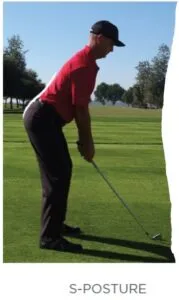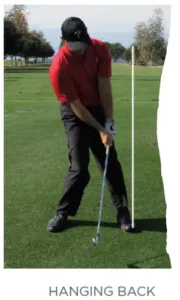Ever wondered why your body aches after a round of golf or a session on the practice range? It could be due to various swing faults that often go unnoticed but can significantly impact your game and your body’s health. Let’s delve into the common culprits and how they contribute to those post-golf pains.
How Your Swing May Be Hurting You
Common swing faults that we may see leading to a golfer’s back hurting are:
- Reverse Spine Angle
- S-Posture
- Early Extension
- Hanging Back / Restricted Lead Hip
All of these swing faults can lead to lower back pain among other things (shoulder, hip, elbow issues).
Reverse Spine Angle

Reverse spine angle occurs when there’s excessive backward bend or left side-bend of the torso during the golf swing, often caused by upper body dominance due to limited lower body initiation. This issue can stem from a lack of upper body separation, possibly exacerbated by arm or grip tension and limited hip internal rotation on the trail hip. Insufficient spine rotation and thoracic/lumbar flexibility may also contribute. The resulting lower back pain hinges on the downswing technique. Initiating the downswing by abruptly returning from the tilted spine to the trail hip can subject the spine to increased compressive forces, leading to irritation in the joints, muscles, discs, and nerves, particularly on the right side for right-handed golfers.
What exercises should you do?
To address this swing fault effectively, it’s crucial to identify the underlying limitation causing it. This insight will guide the selection of exercises best suited to your needs. Consider swing modifications such as shortening your backswing, maintaining a neutral pelvis, or adjusting your ball position, which can be discussed with a knowledgeable golf coach. If you’re currently experiencing pain and suspect a reverse spine angle in your swing, consulting a medical professional can help alleviate discomfort and provide tailored exercises to prevent recurrence. Stay tuned for future articles where we’ll delve into additional exercises to enhance your golf performance and address common swing faults.
S-Posture

This setup posture significantly contributes to lower back pain by placing undue stress on the lower back muscles and stretching the abdominal muscles. This imbalance can result in a loss of posture or reverse spine angle during the backswing, complicating the downswing sequence. Muscular imbalances, including tight hip flexors, lower back, weak glutes, and core, often exacerbate this posture. Additionally, improper hip bending technique or misguided advice, such as protruding the buttocks or excessive knee flexion with an upright torso, can also lead to this S-posture setup. Understanding and correcting these factors are essential for alleviating lower back pain and improving golf performance.
Early Extension

Early extension in golf is characterized by any lower body movement toward the ball during the downswing, often resulting in the club and arms lagging behind the body and causing it to lift up. This swing fault commonly leads to the dreaded double miss – a block to the right and a hook to the left. Lack of mobility, strength imbalances, and poor ground interaction are key contributors to early extension. This prevalent fault can significantly stress the right hip and lead to right-sided lower back pain in right-handed golfers. Stiffness or weakness in the pelvis, thoracic spine, and shoulders can exacerbate this issue, causing forward movement toward the ball during the downswing. Addressing these underlying factors through assessment and targeted interventions is crucial for improving swing quality and preventing injury.


